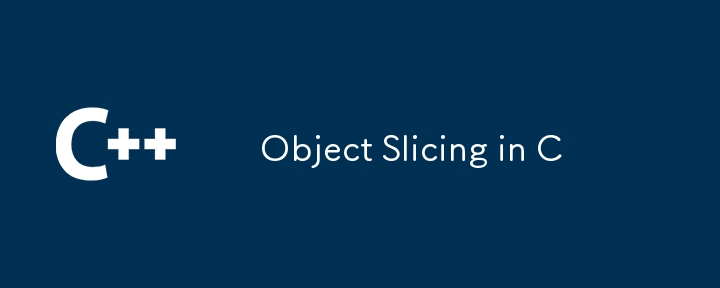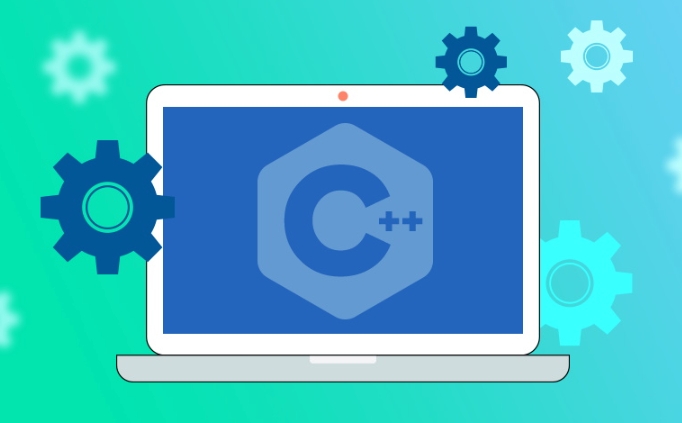Object Slicing in C
Object slice refers to the phenomenon that only part of the base class data is copied when assigning or passing a derived class object to a base class object, resulting in the loss of new members of the derived class. 1. Object slices occur in containers that directly assign values, pass parameters by value, or store polymorphic objects in storage base classes; 2. The consequences include data loss, abnormal behavior and difficult to debug; 3. Avoiding methods include passing polymorphic objects using pointers or references, or using smart pointers to manage the object life cycle.

In C, Object Slicing is a language feature that is easily overlooked but can cause serious problems. It usually occurs when receiving derived class objects with base class objects, causing the newly added member variables in the derived class to be "cut off", retaining only the part of the base class. This can cause data loss and abnormal behavior problems.

What is object slicing?
Object slices refer to when you assign or pass a derived class object to an object of the base class type, the compiler will only copy the data of the base class part, and the extended members in the derived class will be "cut off".
For example:

struct Base {
int a;
};
struct Derived : Base {
int b;
};
Derived d;
Base b = d; // Object slice happens here, there is no db in b At this time, b only contains a , and the information of db is lost.
What situations are prone to trigger object slicing?
Direct assignment or initialization

Base base = derived; // Slicing happens here
Pass parameters by value
void foo(Base b); Derived d; foo(d); // The parameters are passed by value, and slices will occur
Container storage base class object
std::vector<Base> vec; Derived d; vec.push_back(d); // The stored type is Base, not Derived
In these scenarios, you may mistakenly think that you are operating with complete derived class objects, but in fact only the base class part is preserved.
How to avoid object slicing?
To avoid this problem, the key is not to deal with polymorphic objects in a "value" way, but use pointers or references:
✅ Use pointers (naked pointers or smart pointers)
std::unique_ptr<Base> ptr = std::make_unique<Derived>();
✅ Pass parameters using references
void foo(const Base& b); // Can't slice
✅ If multiple types of objects must be stored in the container, you can:
std::vector<std::unique_ptr<Base>> objects; objects.push_back(std::make_unique<Derived>());
Note: If you just want to access virtual functions, both references and pointers can be dynamically bound correctly; but if member variables are involved, there will be problems with the copy of the value.
What are the consequences of object slicing?
- Data Loss: Additional members in the derived class will not be copied.
- Behavior error: If the derived class overrides the virtual function but is sliced during the value transfer process, although the function can be called normally, it operates in the wrong object state.
- Difficult to debug: the slice will not report an error, the running result may seem "reasonable", but it is logically wrong.
for example:
struct Animal {
virtual void speak() { cout << "..." << endl; }
};
struct Dog : Animal {
void speak() override { cout << "Woof!" << endl; }
};
void makeSpeak(Animal a) {
a.speak();
}
Dog dog;
makeSpeak(dog); // The output may be "...", not "Woof!" Here, even if speak() is a virtual function, it may not be able to show the expected behavior because it becomes an Animal type object after slice.
Basically that's it. Object slicing is not a syntax error, but can cause program behavior abnormalities, especially in polymorphic programming. Just remember: use pointers or references to process polymorphic objects, and do not use values to copy them , to effectively avoid this pit.
The above is the detailed content of Object Slicing in C. For more information, please follow other related articles on the PHP Chinese website!

Hot AI Tools

Undress AI Tool
Undress images for free

Undresser.AI Undress
AI-powered app for creating realistic nude photos

AI Clothes Remover
Online AI tool for removing clothes from photos.

Clothoff.io
AI clothes remover

Video Face Swap
Swap faces in any video effortlessly with our completely free AI face swap tool!

Hot Article

Hot Tools

Notepad++7.3.1
Easy-to-use and free code editor

SublimeText3 Chinese version
Chinese version, very easy to use

Zend Studio 13.0.1
Powerful PHP integrated development environment

Dreamweaver CS6
Visual web development tools

SublimeText3 Mac version
God-level code editing software (SublimeText3)

Hot Topics
 1793
1793
 16
16
 1736
1736
 56
56
 1587
1587
 29
29
 267
267
 587
587
 What is a POD (Plain Old Data) type in C ?
Jul 12, 2025 am 02:15 AM
What is a POD (Plain Old Data) type in C ?
Jul 12, 2025 am 02:15 AM
In C, the POD (PlainOldData) type refers to a type with a simple structure and compatible with C language data processing. It needs to meet two conditions: it has ordinary copy semantics, which can be copied by memcpy; it has a standard layout and the memory structure is predictable. Specific requirements include: all non-static members are public, no user-defined constructors or destructors, no virtual functions or base classes, and all non-static members themselves are PODs. For example structPoint{intx;inty;} is POD. Its uses include binary I/O, C interoperability, performance optimization, etc. You can check whether the type is POD through std::is_pod, but it is recommended to use std::is_trivia after C 11.
 How to pass a function as a parameter in C ?
Jul 12, 2025 am 01:34 AM
How to pass a function as a parameter in C ?
Jul 12, 2025 am 01:34 AM
In C, there are three main ways to pass functions as parameters: using function pointers, std::function and Lambda expressions, and template generics. 1. Function pointers are the most basic method, suitable for simple scenarios or C interface compatible, but poor readability; 2. Std::function combined with Lambda expressions is a recommended method in modern C, supporting a variety of callable objects and being type-safe; 3. Template generic methods are the most flexible, suitable for library code or general logic, but may increase the compilation time and code volume. Lambdas that capture the context must be passed through std::function or template and cannot be converted directly into function pointers.
 What is the mutable keyword in C ?
Jul 12, 2025 am 03:03 AM
What is the mutable keyword in C ?
Jul 12, 2025 am 03:03 AM
In C, the mutable keyword is used to allow the object to be modified, even if the object is declared as const. Its core purpose is to maintain the logical constants of the object while allowing internal state changes, which are commonly found in cache, debug counters and thread synchronization primitives. When using it, mutable must be placed before the data member in the class definition, and it only applies to data members rather than global or local variables. In best practice, abuse should be avoided, concurrent synchronization should be paid attention to, and external behavior should be ensured. For example, std::shared_ptr uses mutable to manage reference counting to achieve thread safety and const correctness.
 What is memory alignment and why is it important in C ?
Jul 13, 2025 am 01:01 AM
What is memory alignment and why is it important in C ?
Jul 13, 2025 am 01:01 AM
MemoryalignmentinC referstoplacingdataatspecificmemoryaddressesthataremultiplesofavalue,typicallythesizeofthedatatype,whichimprovesperformanceandcorrectness.1.Itensuresdatatypeslikeintegersordoublesstartataddressesdivisiblebytheiralignmentrequiremen
 How to generate a UUID/GUID in C ?
Jul 13, 2025 am 02:35 AM
How to generate a UUID/GUID in C ?
Jul 13, 2025 am 02:35 AM
There are three effective ways to generate UUIDs or GUIDs in C: 1. Use the Boost library, which provides multi-version support and is simple to interface; 2. Manually generate Version4UUIDs suitable for simple needs; 3. Use platform-specific APIs (such as Windows' CoCreateGuid), without third-party dependencies. Boost is suitable for most modern projects, manual implementation is suitable for lightweight scenarios, and platform API is suitable for enterprise environments.
 C vs Python performance
Jul 13, 2025 am 01:42 AM
C vs Python performance
Jul 13, 2025 am 01:42 AM
C is usually faster than Python, especially in compute-intensive tasks. 1.C is a compiled language that directly runs machine code, while Python executes while interpreting and executing, which brings additional overhead; 2.C determines the type during compilation and manages memory manually, which is conducive to CPU optimization, and Python dynamic typing and garbage collection increase burden; 3. It is recommended to be used for high-performance scenarios such as game engines and embedded systems. Python is suitable for data analysis and rapid development scenarios with priority efficiency; 4. Performance testing is recommended to use time tools, eliminate I/O interference, and average values multiple times to obtain accurate results.
 Understanding move assignment operator in C
Jul 16, 2025 am 02:20 AM
Understanding move assignment operator in C
Jul 16, 2025 am 02:20 AM
ThemoveassignmentoperatorinC isaspecialmemberfunctionthatefficientlytransfersresourcesfromatemporaryobjecttoanexistingone.ItisdefinedasMyClass&operator=(MyClass&&other)noexcept;,takinganon-constrvaluereferencetoallowmodificationofthesour
 Pure Virtual Functions in C
Jul 15, 2025 am 01:52 AM
Pure Virtual Functions in C
Jul 15, 2025 am 01:52 AM
Pure virtual functions are the key mechanisms used in C to define abstract classes and interfaces, and their core role is to force derived classes to implement specific methods. 1. The pure virtual function is declared through virtualvoidfunc()=0; and the implementation is not provided, making the class an abstract class and cannot be instantiated; 2. It is used to simulate the interface to ensure that the subclass must rewrite the method, such as the draw() of the Shape base class in the graphics library; 3. Supports runtime polymorphism, allowing the base class pointer to call the implementation of different subclasses; 4. Although the abstract class cannot create objects, it can contain constructors, member variables and implemented ordinary functions; 5. If the derived class does not fully implement all pure virtual functions, it will also become an abstract class; 6. In special cases, the pure virtual function can provide default implementation for derivation.






